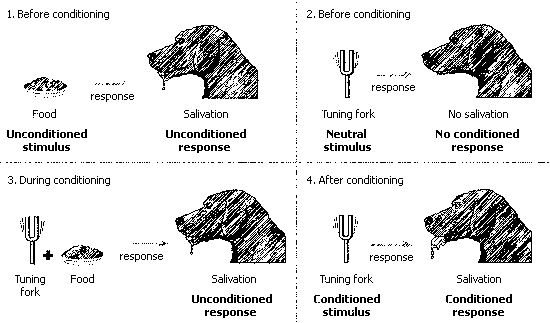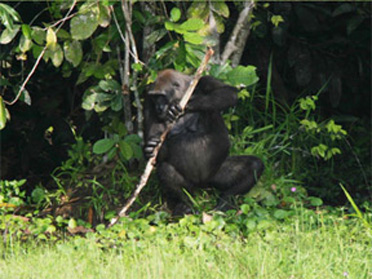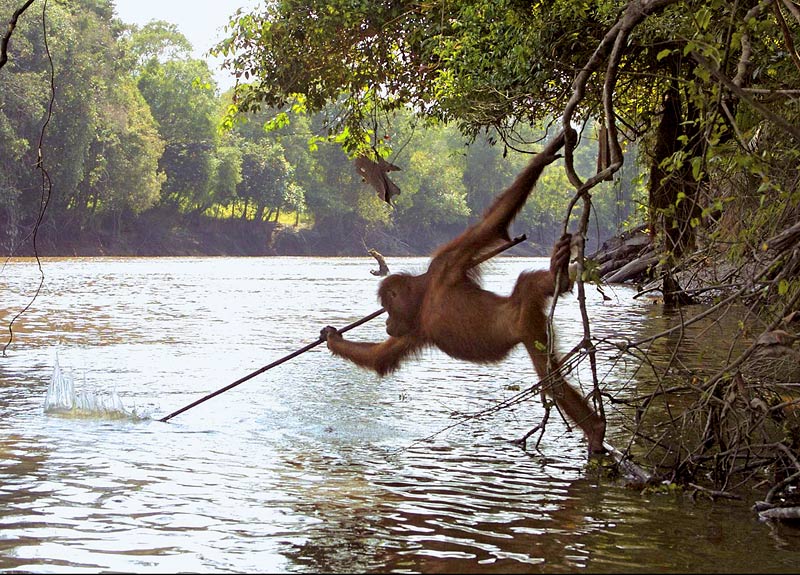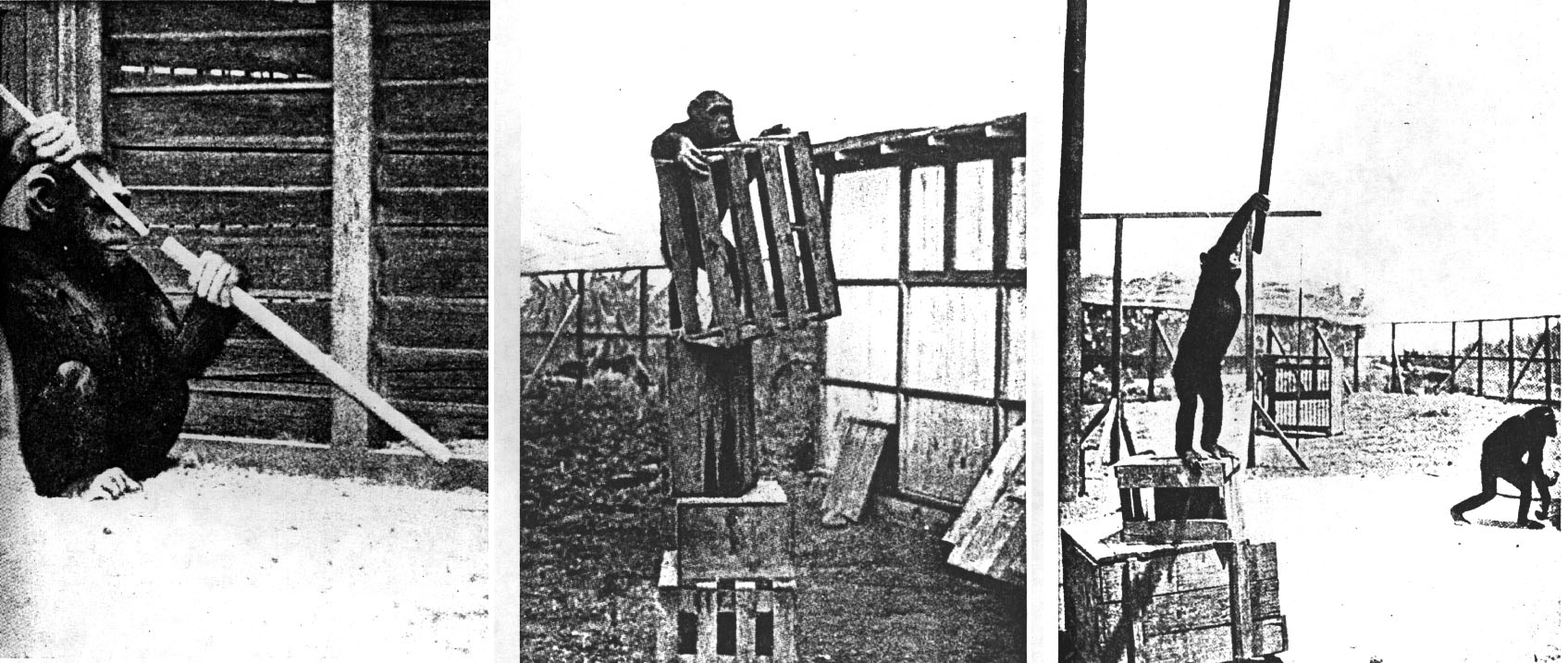Chapter One
The behavior of Anthropoid Chimpanzees
Three Stages in the Development of Behavior
First Stage
The first stage is formed by inherited reactions or innate modes of behavior (Instincts). They are associated with the satisfaction of the basic needs of the organism. They function by virtue of the organism’s inherited structure, without any form of training. E.g. A newborn child will move his hands and feet, cry out, suck his mother’s breast, and swallow milk. These behaviors are not learnt. The biological value of the instinctive reaction lies in the fact that they are useful adaptations to the environment, developed in the struggle for existence and reinforced by natural selection in the process of biological evolution. Lower animals’ (insects and other invertebrates) behaviors consist almost exclusively of such instinctive reaction. E.g. the spider spins its web etc.
Second Stage
It is the stage of training or conditioned reflexes. These behaviors are not inherited, but rather arise in the course of the animal’s own experience. Two points characteristic of the second stage are noted:
The first point is the connection that exists between the reactions of this second stage and the instinctive or inherited reactions. Conditioned reflexes arise on the basis of unconditioned reflex or inherited instinctive reaction. Animal training does not create new reactions in the animal; it only combines the innate reactions, as well as completely new conditioned corrections between the innate reactions and stimuli from the environment.
The second point may be found in the new biological function performed by the conditioned reflexes.
The full development of the second stage of behavior is found only in the vertebrates. In the higher animals, a plasticity in innate capacities manifest itself for the first time, together with childhood in the proper sense of the term, and the concept of play we associate with the child. Play, itself an instinctive activity, also serves to exercise other instincts, and is the natural school of the young animal. The inverse influence of the second stage upon the first happens when the conditioned reflexes change instinctive reflexes in profound ways and very often as a result of the animal’s individual’s experience we observe a “distortion of the instincts”. Ex. Pavlov's experiments:

Picture's source: http://schoolworkhelper.net/2010/08/the-life-and-work-of-ivan-pavlov/
Third Stage (Anthropoid apes)
The third stage is formed by rational behavior or intelligence. Hints of higher forms in the lower species of animals may be understood only if the higher form is already known. Wolfgang Köhler believed the invention and use of tools to be the most essential and distinctive elements of human behavior. For this reason he set out to demonstrate that rudimentary versions of these forms of behavior may be discovered even in the anthropoid apes. He conducted his experiments from 1912 to 1920. Nine apes (chimpanzees) were observed. These experiments are important not only to explain of the development of behavior upwards-from the ape to human-but also for a correct explanation of the development of behavior from the bottom up-from instinct through the conditioned reflexes to intelligence.
The foundation of Köhler’s experiments is formed by three basic operations. 1) The animal had to find roundabout paths to attaining some objectives; 2) It involved circumventing or eliminating obstacles that the animal encountered in the path to the objective; and 3) It involved the use, invention, or manufacture of tools as means for reaching an objective.
Köhler’s Experiments
The use, invention, or manufacture of tools as means for reaching an objective


Use of sticks as tools
In the games that the chimpanzees played, it is easy to discover the close connection between games and the animal’s real life experience. The animal quite easily transfer different techniques and modes of behavior from play to concrete situations in his own life and, conversely, a novel vital experience or a problem that has just been solved is at once transformed by the animals into play i. e. the use of poles to reach food, the use of straw to eat ants, the use of sticks to brush dirt off their bodies, reach out to touch a lizard, the charged wire netting etc, dig up grass roots, as well the use of sticks as shovels, levers and weapons.
Use of ropes as tools
The simplest of the experiments: A fruit was tied to a rope and put in front of a cage, all the chimpanzees, without thinking, would drag the fruit closer to themselves by holding onto the end of the rope. They made use of the rope as a tool to attain the fruit.
Several rope stretched into the cage from a piece of fruit lying outside the cage, though only one of the ropes was attached to the fruit, the others simply placed in the space between the animal and the banana. The chimpanzees usually tugged at the shorter rope. This underscores the importance of visual factors, i. e., the structure of the visual field and the visual contact established between the tool and the objective.
The structure of the visual field and the visual contact
This is proven by another experiment. A piece of fruit lay in front of the cage without any rope attached to it, but there was a stick inside the cage. The chimpanzee was successful only when the fruit and stick were close to each other.
More complex techniques
A more complex technique discovered by Sultan (the most intelligent chimpanzee in Köhler’s experiments) represents a true example of the invention and manufacture of a special tool. He combined two pieces of short bamboos to form long stick to attain fruit. The chimpanzees would use boxes, doors or combine tools (boxes and stick) to reach fruit. The use of boxes has uncovered an extraordinary interesting detail in the chimpanzee’s behavior. The chimpanzee lacks a true understanding of the statics of his constructions.

Kohler's chimpanzee Sultan showed "insight" in
solving a problem. First he assembled a stick, then piled up boxes, then
used the stick to reach a banana dangling from a tree.
Picture's Source: http://www.psywww.com/intropsych/ch08_animals/chimp_cognition.html
Roundabout Paths
Chimpanzees quickly master other experiments that require the use of roundabout paths to the attainment of some objective. Only the cleverest chimpanzee solved this roundabout path problem.
Obstacles
Experiments involving obstacles proved to be far more difficult for the animals than were those requiring roundabouts paths. Karl Bühler writes, “A climbing animal certainly will bypass obstacles that are in his way in the forest, as he hardly ever needs to remove them.”
The Law of Structure and the Behavior of Chimpanzees
Everything done by the Chimpanzees in Köhler’s experiments was closely related to spatial perception. Their ability to discover roundabout paths, remove obstacles, and use tools all proved to be a function of their visual field. They perceived this visual field as a known whole, a structure, and as a result each individual element of this field (i.e. a stick) acquired the value or function of a part of this structure. Ex. The stick became a tool because it belonged to the same structure as fruit.
Köhler concludes that a law of structure governs the behavior of the chimpanzees. According to this law, all the processes of our behavior and concepts do not consist of a mere aggregate of separate; on the contrary, both our actions and our perceptions constitute known whole whose properties define the function and value of each or its components. Köhler’s experiments elucidating the meaning of structure involved a child, a chimpanzee and a chicken.
Experiment: Chicken + dark gray sheet + light gray sheet (with grains)
(Chicken) Chicken + light gray sheet + white gray sheet
Experiment: Stick+ rope + ring = unsolvable
(Chimpanzees) Stick + ring = easier
Basket + ring + loop + rope = solved by Sultan
Besides, both during play and during genuine experiments the animals transfer experience or problem solving methods they have acquired to the other animals.
Intelligence and the Natural Experience of Chimpanzees
In Bühler’s opinion, a considerable proportion of the chimpanzees’ actions must be ascribed to their instinct and to natural training in the forest. (Ex. The principle of the roundabout path and the principle of reaching the fruit by bending a branch or breaking it off or pulling it towards itself, the use of stick as tools, the technique of lengthening a stick etc) He thinks that the detail of Köhler’s experiments has its own prototype in the chimpanzee’s natural forms of behavior.
The second stage is built upon the first, and presents now an entirely new quality, new forms of behavior, and a new biological function, so the third stage, or the intelligent reactions, which arises out of a complex combination of conditioned reflexes, produces a new form of behavior that possesses its own particular biological function.
The situation devised by Köhler is truly reminiscent of that encountered by the chimpanzees in the forest. In the experiments, they reestablished the prior situation under the new conditions. Ex. Reunite the fruit and the branch. Other types of transfer are the result of the effect of a law of structure. Ex. Branch, stick, straw, along piece of cloth. This suggests the relative independence of the structure, as a whole, from any change in its individual elements.
The chimpanzee’s intellectual reaction is in response to a particular obstacle, delay, difficulty or obstruction that is in its way. K. Groos writes about the acquisition of new modes of functioning, “As soon as the repetition of a habitual reaction is interrupted, is delayed, or diverted, consciousness immediately hurries to take its place in order to resume control of operations it had placed in the care of the unconsciously functioning nervous system.” This is the pre-existing conditions that mainly constitute the causes for the emergence of mental phenomena. Bühler is of the belief that Lipps’ “law of weir”[1] could in fact serve as an important and seemingly biological predictable condition for the interference of higher levels of our nervous system and mental life in the activity of deeper, underlying levels.
From the simplest experiments on the animals, it is easily seen that every delay or obstacle in the path of an instinctive or habitual mode of functioning amplifies nervous excitement and induces an enhancement and overproduction of movement. Ex. Chicken’s hyperkinesis when failed to squeeze through the narrow holes in the fence, the ant with a placed obstacle in its path, a caged dog barks to the meat outside its cage. However, the chimpanzee behaves just like the lower animals at first. Then, a sharp and abrupt change appears quite soon in the chimpanzee’s behavior. He usually ceases all external reactions; it seems to become immobile, staring at its goal. The amplified nervous excitation is not expended externally but is transformed into a kind of complex internal process.
Intelligence as the Third Stage in the Development of Behavior
There are new and distinguished features exhibited by the chimpanzees (Köhler’s experiments) that profoundly distinguish it from the second stage in the development of behavior (conditioned or learned reaction).
1) Genesis (the most significant)
Conditioned reflex is established as a result of learning or training and it arises slowly and gradually through repetitions. However, the appearance of reactions in apes occurs quite differently. Once the chimpanzee has found the correct solution to its problem, it will solve it without coaching, repetition, or reinforcement. The chimpanzee manifests the “instant and permanent” memorization. Bühler compared this result with the well-known fact from the realm of the human memory. Some psychologists find an explanation of this result in the law of structure. There is a direct link between this greater facility for memorization, and the difficulty and stress that accompanies the chimpanzee’s intellectual reaction. It is easier to remember what is difficult than what is easy.
2) Biological function
In Köhler’s experiments, the chimpanzee makes discoveries, he invents. Bühler writes, “Invention in the true sense of the term is also a biological function of intelligence…… the anthropoid apes use tools and, when circumstances require it, themselves create tools.” The operation of the intellect begins at the point where the activity of instinct and the conditioned reflexes ends or is inhibited. The chimpanzee’s conduct was characterised by adaptation to changed conditions, new circumstances and new situation. Bühler wrote, “the difficulty posed by the new situation is overcome not by external devices…… but plainly by an internal process after which a solution suddenly appears.” He compares this sudden change to a similar change of human (Aha-experience).
3) The type of conduct that they found is clearly independent of the specific situation they found it in.
By finding the right solution, the ape at the same time acquires the ability to transfer the solution it has found to the other situations, in which it may be applied very broadly. This finding also distinguishes the ape’s intellectual reaction from conditioned reflexes. Edinger assumes that there’s a new formation in the animal’s brain accounting for the emergence of that new ability. Just as the new brain is built over the old, any new phase stage in the development of behavior, corresponding to the new section of the brain, is also built over the old. Intellect of the apes is the main prerequisite for the development of work and providing a link between the behavior of the ape to man. Factors: The handling of objects and adornment ability. Köhler concluded that chimpanzees exhibit rational behavior of the sort inherent in man.
The Use of Tools as the Psychological Prerequisite for Work
There are certain highly important features to demarcate the behavior of the ape from that of man. Köhler assumes that the absence of the invaluable technical auxiliary (language) and fundamental limitations with regard to highly important material of the intellect (concept). The chimpanzee’s thinking is entirely independent of speech. This suggests that thought and speech in the animal kingdom derive from different genetic roots. The use of tools in the absence of the work both unites and divides the behavior of the ape and the man. The use of tools is not the basis of the apes’ adaptation to the environment. Tools do not play a decisive role in its struggle to survive. According to Engels, work is the basic factor in the process of the transformation of ape into man. He suggests that the first step in the shift from ape to man, was the separation of the functions of hands and feet. The hands could perform entirely new functions (grasp a club and stones, build nests and awnings). Therefore, the liberation of the hand is both a prerequisite and a consequence of the process of work. Work serves to consolidate society. Joint activity and mutual support came to be fundamental. Speech developed out of the processes of work. The process of work requires man to exercise a certain degree of control over his own behavior. This self control is based on the same principle as man’s dominion over nature.
Sphere of adaption to nature
Man Ape
Work √ X
Dominion over nature √ X
Psychological Sphere
Man Ape
Control Over behavior √ X
Ability to exercise dominion over that √ X
behavior by means of artificial symbols
(cultural development of human behavior)
Intellect is the essential prerequisite for the development of work, will power, or control of one’s own behavior, is it direct product and result. According to Engels, freedom is control over oneself and external nature. First people were lack of freedom, but culture took them forward toward freedom. Thus, there is a turning point in the sphere of human psychological development when tools were introduced and when they began to be used. The enhancement of the “means of work” and the “mean of behavior”, in the form of language and other systems of symbols, serve as auxiliaries in the process of the control of behavior, now becomes pre-eminent, supplanting the development of the “bare hand and the intellect left of itself”.
Ape has the necessary prerequisites for the beginning of work, in the form of the development of the hand and intellect, which together lead to the use of tools; however, there are no prerequisites for self-control or the use of even the most primitive symbols.
[1] This law asserts that if the flow of some psychological process encounters a delay or an obstruction, there will occur, at the site of the delay, an increase in nervous energy, and an increase in the force and activity of the process itself, while in response to the obstacle the process will, with greater effort, strive to either overcome the delay or get around it by some roundabout path.